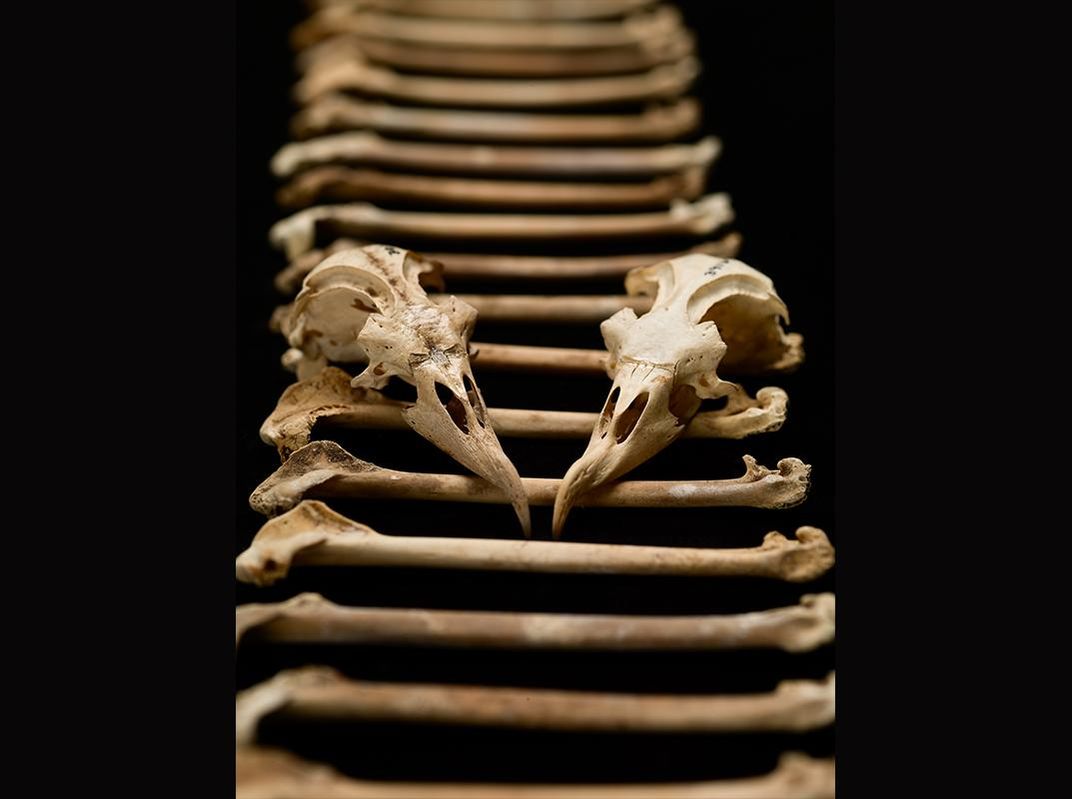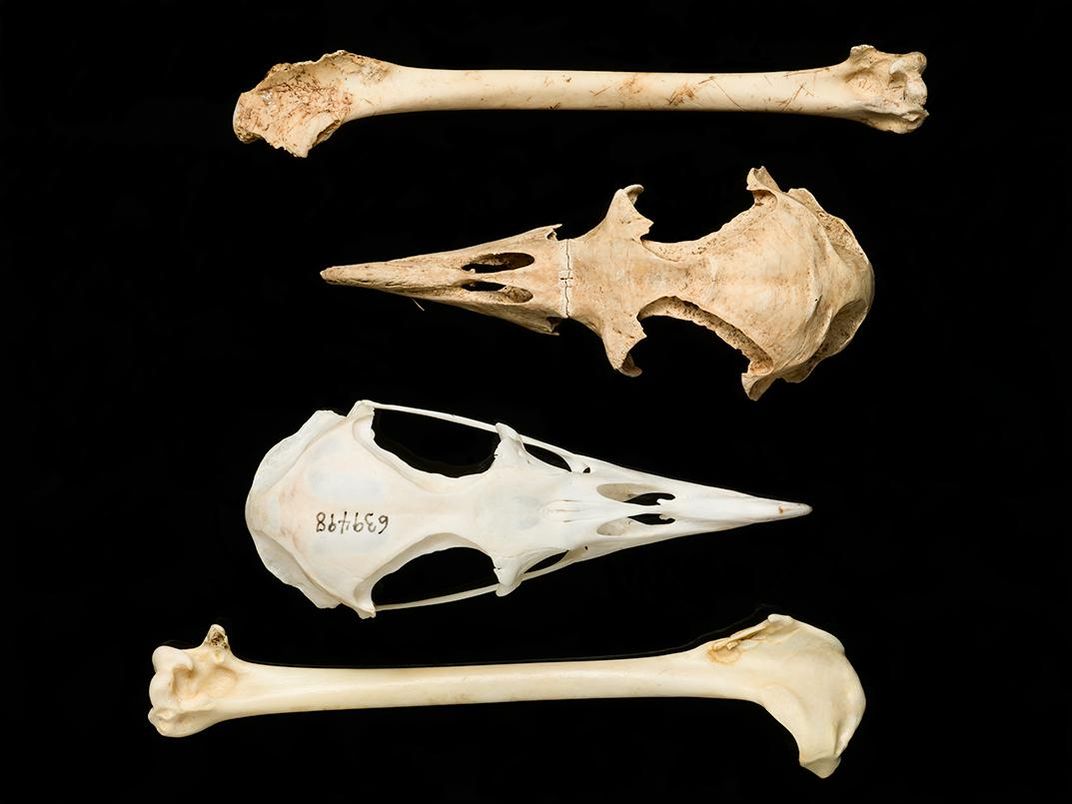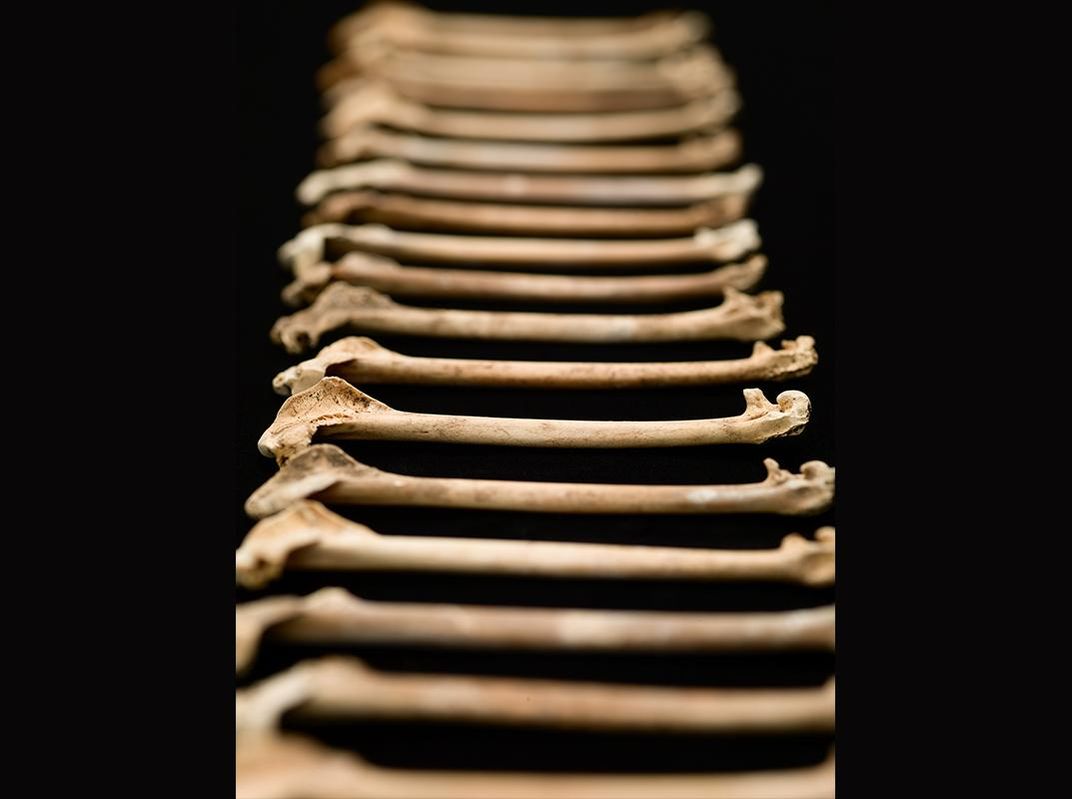Bones of the Hawaiian Petrel Open Up a Window Into the Birds’ Changing Diet
Industrial fishing may play a role in the shift
/https://tf-cmsv2-smithsonianmag-media.s3.amazonaws.com/filer/80/1a/801ae7bf-5e6d-4de7-b08b-63759d6c9fbb/hawaiianpetrelweb.jpg)
For the majority of its wandering life, the Hawaiian petrel is a mystery, traveling in a mysterious place. Returning to land—to a few specific islands in Hawaii—only to nest and breed, these pelagic birds, who have been on the endangered species list since 1967, are primarily vagabonds of the northern Pacific Ocean, a vast expanse between the equator and Alaska’s Aleutian Islands.
As such, they are a wide-ranging species within an enormous ecosystem that eludes scientists who are working to understand how climate change, industrial fishing practices, and other natural and human and influences are affecting the Pacific Ocean. Now, the bones of these birds—some as old as 2,000 years—are providing scientists a unique window into this ocean’s ecological past, as well as baseline data from which to better understand its present and consider its future.
The results of a recent study, published in the Proceedings of the Royal Society B, show how a refined examination of the bones’ chemistry confirms a shift in the northern Pacific’s food web—the intricate, interconnected network of food chains that sustains every species from the most microscopic plankton to the gigantic blue whale. In essence, the bones are telling scientists that the petrels’ food chain has, in the last 100 years, grown shorter.
How and why is not clear, but understanding where a species eats in a food chain is just as critical—and from a long-term perspective even more important—than what they eat.
So this information, and the new methods scientists are using to interrogate the bones themselves, are providing a way to begin to answer those questions.
“If major shifts are taking place in this ecosystem, and we have no way of gauging how fast and how large those shifts are, then it’s hard for us to manage the resource. It’s hard for us to predict whether there could be a tipping point where even larger changes could occur,” says Helen James, a research zoologist and curator of birds at the Smithsonian’s National Museum of Natural History, who is a co-author of the study.
These bones, many of them from the Natural History Museum and other museums, as well as from recent birds, enable scientists to tell an invaluable long-term story dating from thousands of years ago to the present.
“Once you have a baseline in this kind of data, continuing to sample into the future can be a great way to detect signs of ecosystem stress,” says James.
Food chains seem rather linear and simple; they are a species’ specific eating path within the food web. For instance, a shark eats a tuna, which has eaten parrotfish, which has eaten a coral, which has eaten a phytoplankton. Where species eat in a food chain is important to know, and scientists define that based on what are called trophic levels.
Level one are the producers, who use light to photosynthesize and produce food; these are primarily phytoplankton, which form the foundation of the entire oceanic food web and its myriad chains. At level two, herbivores—tiny grazing animals like zooplankton, jellyfish, sea urchins, as well as larger animals like parrotfish and green turtles—move through the sea, grazing opportunistically. Level three is made up of small carnivores like sardines, menhaden, and other species that feed on the herbivores and primarily serve as food for the species at level four, the top predators including large fish, mammals, and birds—like Hawaiian petrels—which eat the smaller carnivores.
Although food chains are distinct to each animal, because they are interconnected within the much larger food web, what happens to one animal’s food chain will invariably cause a shift elsewhere in the web.
If, for instance, the practice of finning sharks depletes the population of this level four predator in a particular area, the animals further down the sharks’ food chain will become more abundant (fewer sharks to eat them).
Suddenly, they are eating more of the animals beneath them. Species tangential to the sharks’ food chain, which seem to have nothing to do with sharks but depend upon the smaller animals that are suddenly disappearing under more feeding pressure, will see their food sources disrupted and may also be forced to eat species at a lower trophic level. This is, in effect, a trophic shift—the length of the species’ food chain has changed.
And this is what the chemistry of the Hawaiian petrels’ bones is revealing in the northern Pacific. In 2013, James and other scientists first approached this question by studying the bones of every breeding population of the species—doable, because they only breed on specific islands in Hawaii.
“Each petrel flies great distances over the northern Pacific Ocean, feeding along the way and slowly incorporating nitrogen from its diet into the protein in its bones,” says James. “Imagine we had a drone and released it over this vast area, and it flew across the ocean taking samples of the food web in a systematic way. After the petrel (or drone) dies, information about its feeding habits is preserved for hundreds or thousands of years inside its bones. If we can find those bones and extract proteins from them, we have an unexpected source of data about how ocean food webs have changed on a broad scale, through time.”
The scientists can’t know exactly what the birds have eaten—that specific kind of information, of course, can’t be stored in bones. But by interrogating the chemistry within the bones, they can determine the chemistry of the foods the birds have eaten, and through this see whether a change has happened.
“Looking at food on a chemical level, there’s a single chemical number we can get to which says something about the birds’ food chain, which you couldn’t have if you just had a list of what the bird ate yesterday,” James says. “So there’s a real advantage to looking at this chemical signature if you want to look at long-term trends.”
In the 2013 study, the scientists examined nitrogen, which is incorporated cumulatively and predictably when one organism eats another, and found that the entire species showed a decline in nitrogen isotopes within the past 100 years. This indicated that the birds’ food chain had become shorter; somewhere in the birds’ food chain, animals were eating at a lower trophic level.
In the current study, the scientists wanted to refine their methodology to determine that the 2013 study had indeed revealed a shift in the birds’ food chain, not a change caused by the chemistry of the nitrogen at the bottom of the food chain, as others had argued. This time, they looked at the relationship between two specific amino acids and their nitrogen isotopes, which, when taken together, can indicate the length of that specific bird’s food chain.
This more precise method confirmed that the modern food chain of petrels is shorter than the ancient one, James says.
“There are several steps in the food chain leading up to the petrel, and we don’t know at which step the change occurred,” she says. “It’s conceivable that they’re eating the same species of food, but those species are eating something different.”
As in the first study, the new study suggests that industrial fishing, which began on a large scale in the Pacific early in the 1950s, must be considered as a possible source of this shift.
“We do know that for a lot of the continental shelf marine areas, there is this phenomenon of fishing down the food web—removing a lot of large predatory fish from the ocean. Smaller predators become more abundant, and they have to eat,” James says. Thus, the average catch size becomes smaller, both for humans and other species.
The new data from the petrel bones will help inform ongoing studies and monitoring of fish populations to help better understand what has happened in the enormous ocean that is so challenging to research.
“What we are able to bring into that story is this good-quality historical data, especially going back to where humans weren’t having any effect on the ocean ecosystem,” James says.
Going forward, she and other scientists are expanding their research and applying the new study’s chemical methodology to other species, including the Laysan albatross and Newell’s shearwater. Both, like the Hawaiian petrel, nest in the Hawaiian archipelago but they forage in different regions of the ocean, which will provide further information to examine ocean-wide trends. The Newell’s shearwater is endangered, while the Laysan albatross is considered “near-threatened.”
“These museum specimens are remarkable for the information they can provide about the past,” James says. “They enable us to learn some really unexpected things about ocean ecology.”
/https://tf-cmsv2-smithsonianmag-media.s3.amazonaws.com/accounts/headshot/WendyClarke1.JPG)



/https://tf-cmsv2-smithsonianmag-media.s3.amazonaws.com/accounts/headshot/WendyClarke1.JPG)